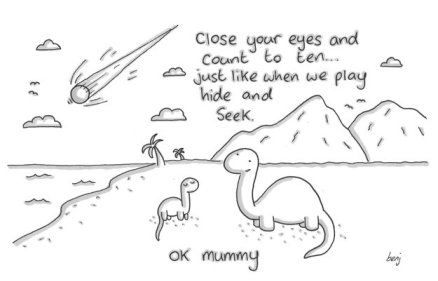The Cambridge Science Festival
This originally appeared at: http://blogs.egu.eu/palaeoblog/?p=1152
Last night, I was honoured to have spoken at the final evening lecture at the Cambridge Science Festival, along with Nick Crumpton, Anjali Goswami, Rob Asher, and Stephanie Pierce, about why palaeontology is important. Below is a rough transcript of some of what my talk was about. Unlike the others, I didn’t discuss my own research. Instead, by general gist was that although palaeontology is useful in addressing some of the greatest scientific questions of our time, like the evolution and history of life on Earth, the current narrow framing of science in terms of impact is being quite detrimental to creativity and exploratory science. As such, should palaeontology be more focused on its emotive qualities, and be used as a ‘hook’, or ‘gateway’ into the other fields of science?
Intro
When people ask me why palaeontology is important, I picture that it’s a drunk guy sitting in a pub, asking why he’s paying taxes for our research. The last thing he probably wants to hear is that it’s going on hunting for dinosaurs or some smidgen of a 500 million year old louse. Sometimes anyway. With science funding bodies being eternally squeezed, academics are being constantly asked what the point of their research is – there’s little space for exploratory, or ‘blue sky’ research any more. Research now often has to be shown to have demonstrable ‘impact’, before you’ve even done it!
One major area of palaeo-research at the moment is focussed towards unravelling large-scale patterns in the environment and biodiversity over millions to tens of millions of years – a concept we call macroevolution. The whole idea is that the past is the key to the present and future – the notion being that this kind of research can give us useful information about what is going to happen in the next 10-100 years with global climatic disruption and the impending biodiversity crisis. No, it doesn’t make much sense to me either, and it’s my field of research! We still haven’t managed to reconcile the time-scale differences, and until we do, looking at above-species level dynamics isn’t really going to tell us much about mitigating climate change or protecting our biodiversity. I know this is just one example of current palaeo research, but it’s certainly a persistent theme throughout many current research areas.
So how do we demonstrate the impact of palaeontology? It doesn’t offer much for the economy, in the same way that new technologies do, or benefit health care much, unless someone starts grinding dinosaur bones for some ridiculous form of holistic medicine. Its use for conservation, when looking back in deep geological time, is a bit tenuous. But does this mean it’s unimportant? Certainly to a politician, or the drunk guy in the pub, it would be difficult to convey the ‘importance’ of palaeontology when so much of science is framed in having some sort of demonstrable economic or environmental impact these days.
But I think palaeontology is unique in that it goes beyond such a simple framing of science.
Palaeontology is what I like to call a ‘gateway science’. Modern palaeontology is a wonderful blend of the other sciences, from zoology to mechanics, and from molecular biology to biochemistry. What it gives us is a unique perspective, an opportunity if you like, to interact with other sciences outside of their usual ‘raw’ applications.
This isn’t to say palaeontology is utterly useless by itself – go down to your local museum, and see the queues and inspired faces when seeing the dinosaurs. Every kid wants to be a dinosaur, but at some point, most of us lose that inspiration, and become estate agents or bankers. I don’t have a clue why this is, but I’m quite happy to lay most of the blame on Michael Gove.
I’d like to give you some examples of how palaeontology can be a ‘gateway science’, and show that palaeontology as an integrative area of research can be used to inspire generations to think about the other sciences in different ways, and with any luck, go on to do great things in them!
Chemical ghosts
What if I told you we now have direct evidence of the remains of cellular material in dinosaurs? You’d probably jump to a similar conclusion to many others I’ve talked about this with – how long until Jurassic Park happens?! Well, that’s still pretty much impossible, as we don’t have any eccentric billionaires to buy us a Pacific Island. Or dinosaur DNA (yet).
My old lecturer, Phil Manning, coined the term ‘chemical ghosts’ – the chemical remains of an animal when the organic matter has decayed away. One example you may have seen in the media are the uses of the chemistry of fossil feathers to determine the colours of ancient dino-birds.
When this was discovered, interpreting colour was initially based on the structure of little melanin-bearing organelles called melanosomes. In modern birds, the structure of these provides information about colour, so it’s safe to say this probably happened with ancient feathered dinosaurs too.
But there has been, and still is, a lot of debate about whether this method is accurate, and whether the organelles are even melanosomes or just bacteria in a lot of cases! Enter chemistry.
Phil and his team used a machine called a synchrotron, which is a particle accelerator similar to the one housed at CERN. They analysed the remains of plumage preserved in Archaeopteryx – after all, what better specimens to bombard with electrons than the most infamous and valuable we have? They were able to map sulphur and trace metals over the whole body of Archaeopteryx, and the distribution of these elements was strongly tied to the preservation of the melanosomes, and allows you to more accurately reconstruct the colour of an animal that has been dead for 150 million years. Additionally, due to the structural implications of having trace metals and melanosomes in feathers, investigating the chemistry can have implications for the mechanics of the feathers, and the early evolution of flight in birds. Similar studies have been carried out in fossil fish too, but well, they’re just fish..
Mary Schweitzer and the Philosopher’s Stone
As well as this Mary Schweitzer and her team from the USA have been exploring molecular-level remains in dinosaurs, mostly with a hadrosaur called Brachylophosaurus, and the notorious T. rex. They’ve published several research papers on it now, each getting largely dismissed by the palaeontological community for what seems little more than pre-conceived notions of what is ‘allowed’ by the fossil record. But each time their work gets knocked down, they come back with a stronger argument for this exceptional preservation.
How do you find the molecular remains of 66 million year old tissue, how were the ravages of time stopped? Chanel has shown great interest in this research, naturally. But again, it comes down to chemistry, this time with a side helping of biotechnology.
In a study from early last year, Schweitzer and her team claimed to have found the remains of proteins in T. rex. They did this by essentially dissolving away the hard, mineralised parts, until all that was left were cell-like microstructures which turned out to be osteocytes, star-shaped cells found in bone. They then used biotechnological and chemical staining techniques that targeted proteins associated with osteocytes in bird-line animals. What they actually found were not the chemical ghosts, but the structural ghosts of DNA-like structures within the cells – an analysis confirmed using dinosaurs extant relatives like ostriches and alligators.
Stealing a technique from analytical chemistry called mass spectrometry, they tested the chemical compositions of these preserved structures, and found that the dinosaurs contain peptides, a type of amino acid, as well as proteins associated with DNA called histones. So not only did they find incredible molecular-level preservation, but also evidence of proteins that you’d expect to find in the ancestors of modern birds, which is pretty cool evidence for their evolutionary descent.
Additionally, using more techniques borrowed from chemistry, they found that a type of ‘tissue fixation’ may be responsible for the preservation of these cellular structures as well as blood vessel networks. This is where in this case, iron, plays some sort of role in stabilising tissue enough so that it is preserved before the onset of organic decay – we’re still trying to figure out the exact processes that take place here. The future of molecular-level discovery in fossils quite simply couldn’t go ahead without a combination of biotechnology and chemistry.
So there we have it – palaeontology can be a gateway into chemistry and biology! I bet ten to fifteen years ago, the link between molecular chemistry and dinosaurs was nothing more than a child’s dream – but it became true. We can now discuss the application of industrial analytical techniques, and those used in medical laboratories around the world, but in the context of something that is arguably more interesting and inspiring to younger generations.
How much of the past is key to the present?
Shifting topic quite dramatically now! I mentioned earlier that when we go back in time, palaeontology isn’t really that useful, in the sense that it can’t tell us much about how biodiversity is going to respond to imminent climate change. This is pretty much because the further you go back in time, the worse the quality of the fossil record becomes, and the more uncertainty goes into our dating and resolution of the rocks and fossils. This pretty much means that despite how cool stuff going on in the Jurassic and further back in time was, and no matter how much we analyse it, it probably won’t ever be informative in the sense that we can use it to guide conservation efforts. Unless we’re talking on a million year time-scale, in which case good luck submitting the grant application for that project.
But what if we burst forward in time to closer to the present? In a period of time called the Quaternary, we have a much better geological and fossil record. We can see oscillations in climate that resulted in fluctuating hot house and ice house worlds, just like you see in the film Ice Age.
To give a few examples, this study shows how the pace of climate change has changed over the last 21,000 years, and how this has impacted on the geographic ranges of species. What we see is a global pattern – the faster climate change happens, the fewer unique species are present, particularly in mammals, birds and amphibians. Through knowing this historical pattern, we can apply it to the modern world – where climate is changing fastest, mammals, birds and amphibians that are unique to those areas will be the most under threat and need most conservation attention.
This next one focusses just on mammals from the Holocene period, from about 11,700 years ago until the present day. As such, it probably represents the best palaeontological record we’ll ever have. The upper graphs show extinction, and the lower graphs show currently threatened species, with raw numbers on the left and proportions on the right. As such, you can use this as a basis to investigate spatial patterns of extinction, and use this to infer how animals in those geographic regions at the present will respond in the future. And of course, once you understand threat at an empirical and quantitative level, you can employ a mitigation strategy much more effectively.
So if we were to create a model of how the environment is going to affect future biodiversity, looking at the recent palaeontological and palaeoecological records is crucial to understand how things have changed in the past, and how similar animals are likely to respond in the future.
A point of ongoing research through all of this is pinpointing exactly what drove extinction, speciation and biogeographic patterns. Was it influenced by human evolution and hunting, environmental factors, something to do with the biology of the animals themselves, some combination of all of these, or just something obscure we haven’t thought of yet.
Either way, the clearer this picture becomes in pinpointing exactly what has driven species’ extinction in the past, the more confident we can be in our conservation efforts in the future. So palaeontology can provide a unique perspective into biology in a conservation or biodiversity-related context, something which is of clear importance in this time of dynamic global change.
Wrap up
One thing I want to emphasise from all of this is not to lose the point of what science is. It’s a human endeavour of the senses – we explore, we ponder, we analyse the natural world around us. This in itself is a wonderful thing, and palaeontology is among the most exploratory of sciences out there. It hits us emotionally, in a way – we always want something that we can’t have, from the stars, to a T. rex. Palaeontology is the girl you were always too afraid to ask out, who moved on, forever. You get that same longing feeling, wondering what could have been. It’s this use of the imagination, I think, which encapsulates palaeontology, and makes it unique.
So while palaeontology isn’t going to shift the economy or solve the next global health crisis, it can inspire people, particularly younger generations, to think in new ways about the different fields of science. And not just that, but think about it creatively and without bounds – palaeontology is science in its purest and rawest form, and we shouldn’t ever forget that.
END
Anyway, I’d love to hear what you all think – why is palaeontology important?




I’ve just got home from two months drilling an exploration oil well in the distant parts of the world, where the day-to-day reports from the on-site palynologist and (night shift) nano-palaeontologist were essential to our understanding of the correlation of the well and it’s interpretation.
It doesn’t get written about much – because it’s as sexy as woollen stocking in a snow storm – but palynology and palaeontology are important industrial tools.